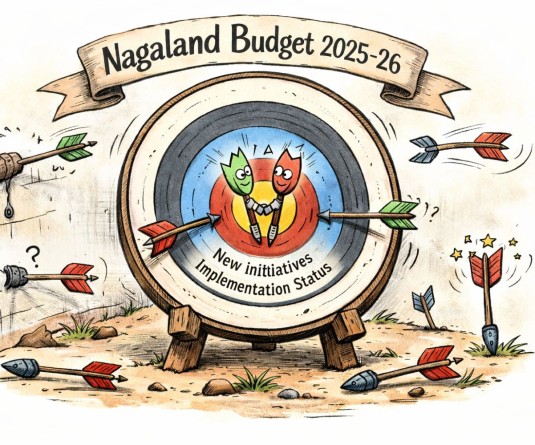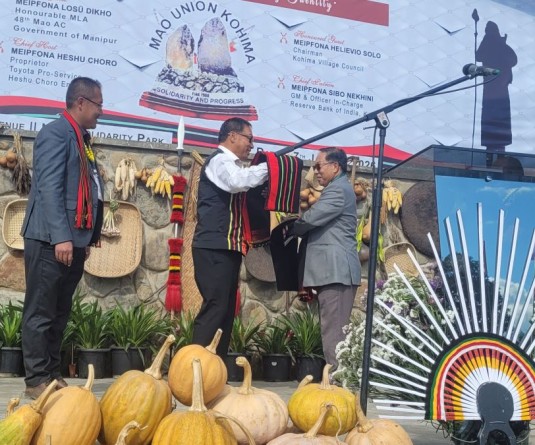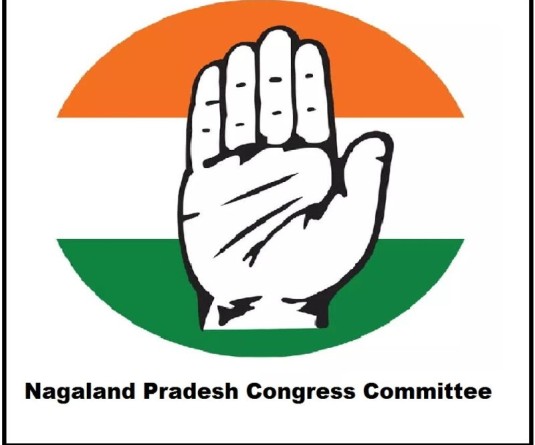
Morung Express Feature
Dimapur | March 4
05.03.2015 is a date that Dimapur neither wants to remember, nor can it forget. On March 5, 2015, as Dimapur watched the day go by in horror, a few people were busy making sure that the incidents of the day did not pour out into future communal hysteria and conflict.
Ahidur Rahman, Working President of the Muslim Council Dimapur, was part of this. For his tireless efforts to maintain communal harmony in the aftermath of March 5, as well as for his work during previous incidents of vulnerability, Rahman was awarded the Peace Award, 2016 on February 1.
To hear his story, The Morung Express met him at his modest business enterprise on MP Road, Dimapur.
Nagaland State
A. Rahman’s father and uncle moved to Dimapur from their ancestral village in Karimganj in 1959 for business. Dimapur, then, was a small transit town in Assam for reaching Manipur. Having observed the formation of Nagaland State in 1963, his father became the first enumerator of Dimapur town, preparing its first ever voter’s list in 1964. This makes Rahman’s family one among the non-Naga indigenous inhabitants of Nagaland State.
Born on August 14, 1965, Rahman and his four siblings were schooled first in Kohima and then in Dimapur. Going to Kohima Baptist English School, “I still remember older Naga boys carrying us on their backs as it was difficult to climb the hill,” recalls Rahman of his childhood. With a thin non Naga population in Kohima back then, and even thinner prejudice, their Naga neighbours gave his sister a Naga name.
In Kohima, his father opened the first retail shoe store and only moved to Dimapur when one of the children fell fatally ill. “There was only one Nagaland State Transport bus plying between Kohima and Dimapur those days. No taxis, no medical facilities. My brother died due to lack of medical attention,” says Rahman of Nagaland in the 1960s-70s. He observed that “development” came “quickly” to Nagaland much too late, mostly in the past three decades.
The sound of gunshots was a regular feature of life in Kohima then. Sleep, or “the undergrounds are coming,” was a common refrain they heard growing up. “We used to think ‘undergrounds’ were a different breed of human beings who lived in jungles,” laughs Rahman, to whom it surfaced only in college that the Nagas were working on a political cause (after a batch mate was picked up by the army). “But having studied in Christian schools with Naga people, I came to understand them better. They are the most peaceful people,” he stresses, time and again, throughout the interview.
In 1977, the family moved to Dimapur—a Dimapur where the highway from Chumukedima to Purana Bazar were lined with sugarcane plantation. From Holy Cross Higher Secondary School, Dimapur to St. Edmund’s College, Shillong to Kohima Science College to Dimapur College (Rail Gate) and even Patkai Christian College, Rahman completed his formal education with a degree in Economics (Honours).
Social work
Rahman was into social work throughout his youth. In 1985, he became the founding general secretary of the Dimapur Muslim Students’ Union. 1987 saw him become an office bearer of the Dimapur College Students’ Union. “Social work gives you the appropriate platform to work closely for the welfare of your community,” reflects the wiry tall Rahman. It is through social work that he had the opportunity to visit places outside Nagaland State. From 1992-2000, he was the general secretary of the Nagaland Muslim Youth Federation. “People outside always wanted to know more about the Naga people, and everything I told them about the Nagas would surprise them—the sharing, caring, liberty, peace.”
Through his time as a leader of his community in Nagaland, Rahman has managed to completely renovate the Muslim Burial Ground, established in Dimapur in 1930. Funds were taken only from the old and established Muslim dwellers of Dimapur. He also managed to convince his community elders to preserve the first religious institution set up in Dimapur in its original form—the Jama Masjid at Hazi Park set up in 1906.
Non Nagas in Dimapur
Today, there are particularly three types of non Naga people living in Dimapur—those settled prior to statehood, the semi permanent business persons and the floating population. Among the third category, a new set has emerged of those who work all day in Nagaland but live right outside the Nagaland State border, in Khatkhati, Lahorijan etc. in Assam.
Rahman patiently postulates that as the Naga population in Dimapur increased, so did the population of labour—farm hands, rickshaw drivers, domestic helpers, drivers, cobblers, shopkeepers, mechanics—from outside Nagaland State. As more funds were pooled into Nagaland by the Government of India, most of it was pooled out. Since the 1980s, thus, employment opportunities were created for people from other states which led to the rapid drain of the Naga economy.
“With the Naga population booming, jobs are not easily available and a tough competition has begun,” says the leader of the Muslim Council Dimapur (MCD) which was set up in 2000. “There are many who create problems but we want to show that our’s is a good population. The floating population’s misdeeds and lack of education within our community has been hampering us but we have been trying to change that of late by encouraging education,” he informs.
Of the people who have been here since before statehood, he explains, “Our people came here to earn a living and now there is no way to go back. We have to follow some guidelines when staying in someone’s home.” In 2012, Rahman realised that the police could not trace the addresses of the accused persons in a gang rape in Dimapur, and set up a process for the registration of all Muslim people living in Dimapur at their closest Jama Masjid. He even went up to the extent of asking makaan maliks to rent out houses only after proper document verification. This led to animosity with certain sections of his community—not everyone is permanent and not all want to register.
Peace making
2012 was a turning point. A huge ‘North East exodus’ began from mainland India. Muslim leaders from Dimapur and Kohima visited Naga students in Bangalore, Pune and Mumbai. “They were so relieved when I started speaking to them in Nagamese,” recalls Rahman. “There are more than 6000 Naga students in Bangalore but no Nagaland House; there was no safe space where they could gather and access reliable information from.” He conveyed this message to the then Chief Minister of Nagaland.
Many fears had arisen as a result of rumours. Multimedia Messaging Services were used extensively to spread them. On the mainland, differences between Burmese, Naga, Bodo, Khasi dissolved—everyone from the subcontinent’s north east to beyond became perpetrators and victims at the same time. “We spoke to Muslim leaders in other cities to lay their fears to rest. We told them Muslim people will not be attacked in Nagaland. There is no communal incident in Nagaland and will never happen.” Those were the words Rahman was held accountable for on March 5, 2015.
The MCD’s work began as soon as protests began on March 4 last year. They tried, in vain, to trace the identity of the person who was lynched by a mob in Dimapur the next day. He was not registered with any of the 70 odd mosques around Dimapur. By the evening of March 4, rumours had spread throughout cities in India, particularly Assam, that Muslim people and religious institutions were under attack in Nagaland. Rahman’s main work was to contain the spread of rumour.
He used social media first—took pictures of the 1906 Jama Masjid, still intact, and posted them on Facebook, asking the community around the sub-continent not to believe in rumours. On March 4 itself, legislators from Dimapur, and leaders from NGOs and apex bodies met him to discuss the situation. Word spread and calls poured in from Delhi, Mumbai, Bangalore. “Though the violence was the work of a few elements, it was difficult to control the media,” the leader observed.
By March 5, he had already asked the State for the protection of religious sites so that no larger problems break forth in case of mob fury—the CRPF was deployed for the purpose. But the actual violence of the day was hard to predict and rolled like a log down the hill. By evening, the man had been lynched.
“Nobody liked the way he was killed but we have to add water to fire, not fuel. We had to consistently tell community leaders from all over India that all Naga people cannot be blamed for the incident, though considerable damage had been done to the Naga image,” Rahman maintained. The “unresolved issue of illegal immigration,” he predicts, will continue to pose a problem as many young Naga people will grow up thinking that “all Muslim people are Bangladeshi,” thereby fanning the fire of hatred and violence on communal lines.
Rahman and his MCD team’s real work began after March 5. There were rumours spreading through Assam that the Nagaland State Government was considering not sending the dead body back to its parent village. A person claiming to be the victim’s uncle in Nagaland laid claim to the body. “If the body had not been sent back, it would have created permanent enmity between Assam and Nagaland, so we had to somehow trace his village in Karimganj.”
The MCD, moreover, remained concerned for 400-odd Naga students studying in Silchar, even asking the Assam State Government to make sure of their safety. The MCD had, by then, identified the village and address of the lynched victim. On March 7, the Nagaland State Government handed over the body to the MCD, which then cleaned it and wrapped it up in white cloth to be sent back home.
“We got calls from all over Assam to let the vehicle bringing the body pass through their areas—he had become a hero there. 5000 people, alongside media, had already gathered at Khatkhati to see the body. It would have taken 2-3 days for the body to reach and could have created huge tensions, egged on by Assam’s media. So we made a spot decision to fly the body. The Assam Government provided a helicopter, the body was flown out and a major anti-Naga wave averted,” narrates Rahman, every incident from those few days clear in his memory, and acknowledges how many people from Assam had also helped resolve the issue.
In its aftermath, nearly 10,000 Muslim people left Nagaland State in three days, mostly on foot, into Assam. Leaders in Assam, many playing vote bank politics, projected that people of the faith were being locked up or being forced to leave. “Some people were even setting up displaced persons camps on the outskirts of Dimapur. We went and told them there was no need for all this! It would send a wrong message. There is no threat to people residing in Nagaland,” said Rahman. When he gave interviews with positive messages on media channels, the media in Assam refused to telecast him. In some pockets, his photos were burnt and he received threatening calls. “They wanted tit-for-tat. We asked them not to disturb us. Naga people are not against us.” The 10-15 days following the incident, people all over Nagaland remained tense. Through the MCD, messages were sent to all districts for people to remain calm. “Every Naga individual and organisation played their part to maintain peace, as did the media in Nagaland,” says Rahman.
In all this, the Nagaland State Government was often held accountable for its slow response. But Rahman waves them off. “The Chief Minister and Home Minister called me on March 6 informing me of their decision to suspend the officials concerned. The State Government delegation was constantly in touch with us. The new DC took office on Saturday, and called a meeting with all of us on Sunday,” he lists out of the State Government’s activities.
Peace award and way forward
The Muslim Council Dimapur, and A Rahman’s, contributions were not overlooked. For his tireless efforts to maintain communal harmony in the aftermath of March 5, as well as for his work during previous incidents of vulnerability, Rahman was awarded the Peace Award, 2016 on February 1. Being the first non Naga to bag the prestigious award, Rahman joined the peace stalwarts club that include the likes of Niketu Iralu and Dr. Wati Aier.
“This is a great recognition. It is proof that non Naga people are equally valuable in Nagaland,” acknowledges Rahman, who is happy to have received the award at the 2nd National Peace Convention held in Dimapur. It is non Nagas, he believes, who have “taken advantage” of the Naga people but “destroyed their image worldwide.”
“Naga people are always willing to help you. No Naga household will refuse food and water to you. The churches have done a great job in raising the Naga people, which is why many crimes from the world outside are unknown here till date. Brand Naga needs to be promoted better and we have to be ambassadors for that,” offers Rahman, eternally grateful for “everything” the Naga people have given him.





